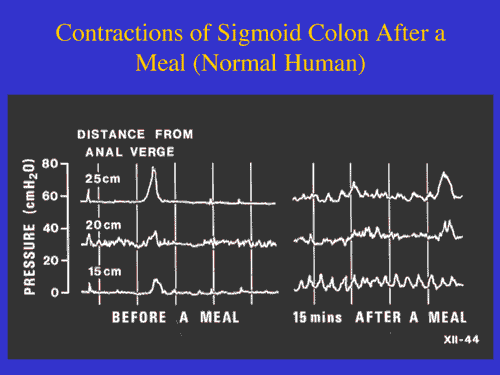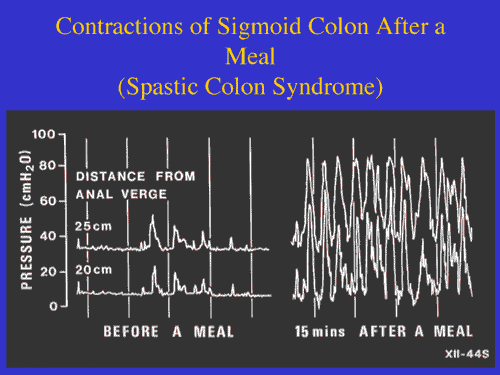The Gastrocolic Reflex & Irritable Bowel Syndrome
The gastrocolic reflex is a partly neurogenic process in which there is an increase in colonic motility, triggered by eating, when food passes from the stomach into the upper part of the small intestine.Irritable Bowel Syndrome, as defined by the Rome Criteria diagnostic guidelines, is characterized as a brain-gut dysfunction; the "gut" portion of this equation is partly due to after-meal deviations from the normal gastrocolic reflex muscle contraction patterns. This is what leads to the altered bowel habits of Irritable Bowel Syndrome.
In plain English: the majority of the time the colon is still, barely moving a muscle. Normally, the gastrocolic reflex causes periodic contractions of the colon at different points along its length, at timed intervals. These segmented contractions regulate the flow of waste, and keep it in contact with the bowel wall, allowing water to be absorbed.
However, how the digestive tract is supposed to work is not exactly how it does work for those who have IBS, and the key problem seems to be with the gastrocolic reflex. Specifically, research has found that many IBS patients have highly abnormal ones. The colons of IBS patients have disorganized and significantly more violent and prolonged contractions (leading to diarrhea), or almost no contractions at all (resulting in constipation). This is illustrated quite dramatically in the images below.

This is a normal gut 15 minutes after a meal.

This is an IBS gut 15 minutes after a meal. Holy cow!
Illustration from Irritable Bowel Syndrome (IBS): Examining New Findings and Treatments. Authors: Marvin M. Schuster, MD; Michael D. Crowell, PhD; Nicholas J. Talley, MD, PhD. Continuing Medical Education Activity, Johns Hopkins School of Medicine, October 26, 2000, via Medscape. Used with permission.
These images vividly demonstrate the difference between the after-meal contractions (triggered by the gastrocolic reflex) of a normal person's lower (sigmoid) colon and the contractions of the lower (sigmoid) colon in a person with IBS. The left half of both illustrations shows the colon contractions before a meal, and the rates are very similar and quite modest. Just fifteen minutes after eating, however, the differences in colon contractions as shown on the right sides of the graphics are dramatic. Given the almost off-the-chart severity of the spasms (measured by the vertical axis in terms of pressure) in the IBS patient, triggered by their gastrocolic reflex, it's easy to literally see exactly why the pain and bowel dysfunctions of this disorder can be so extreme.
Don't be intimidated by the "distance from anal verge" legend for the horizontal axis of the chart. This simply means is how far up into the colon from the anus the contractions are being measured (they're either 15, 20, or 25 centimeters up into the colon from the outside of the anus). In other words, the contractions triggered by the gastrocolic reflex from the stomach are affecting the very lower end of the colon only fifteen minutes after a meal has been eaten. This gives a crystal clear explanation for just how an IBS attack can hit so fast and so hard after - or even while - eating.
Irritable Bowel Syndrome is indisputably a physical problem stemming in part from a dysfunctional response to the gastrocolic reflex. IBS colons react to stimuli that do not affect normal colons, and these reactions are much more severe. It is this gut overreaction that causes the lower abdominal cramping and accompanying diarrhea and/or constipation that characterize IBS.
Gut-directed hypnotherapy, one of the most promising methods of treating (and possibly curing) IBS, deals directly with the element of brain-gut dysfunction and an abnormal gastrocolic reflex. To find out more about the gastrocolic reflex, the brain-gut dysfunction, and Irritable Bowel Syndrome, check this essential guide to successfully managing the disorder.
Gastrocolic reflex information excerpted from The First Year: IBS, copyright Heather Van Vorous.
